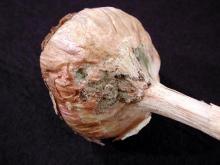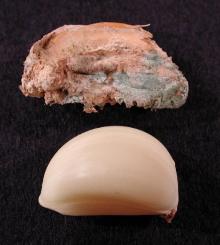Cause Several species of Penicillium, including P. hirsutum (syn. P. corymbiferum), P. aurantiogriseum (syn. P. cyclopium), P. citrinum, P. digitatum, P. expansum, and P. funiculosum have been found to incite blue mold. The fungus does not survive long in soil and is transmitted generally on seed cloves. Infection occurs on wounds sustained when cloves are separated from the parent bulb.
Symptoms Earliest lesions are yellowish but soon are covered with the characteristic blue-green spores. The disease is sometimes referred to as green rot in some areas of the world. The entire clove may be converted into a mass of spores. Infected cloves fail to emerge after planting and result in poor stands.
Cultural control
- Promptly dry or cure harvested bulbs.
- Promptly dry and plant cloves after hot water seed treatment.


